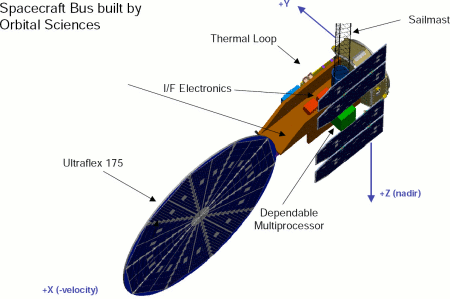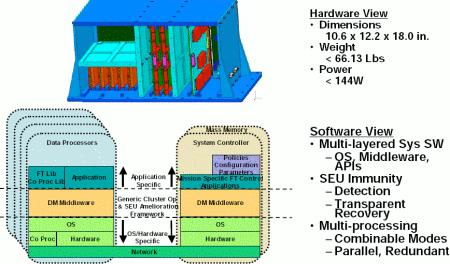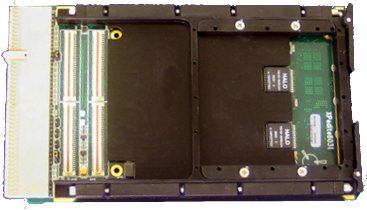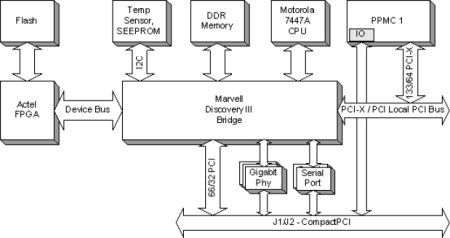NASA tests Linux for spacecraft control
Jun 18, 2007 — by LinuxDevices Staff — from the LinuxDevices Archive — 13 views Linux was selected for a NASA experiment aimed at proving the feasibility of COTS (commercial off-the-shelf) hardware and software for scientific space missions. A key requirement was for application development and runtime environments familiar to scientists, to facilitate porting applications from the lab… to the spacecraft.
Linux was selected for a NASA experiment aimed at proving the feasibility of COTS (commercial off-the-shelf) hardware and software for scientific space missions. A key requirement was for application development and runtime environments familiar to scientists, to facilitate porting applications from the lab… to the spacecraft.
digg this story |
NASA's “Dependable Multiprocessor” (DM) experiment is among four scientific payloads scheduled for launch in November of 2009, in the “New Millennium Program Space Technology 8 (ST8) mission. Honeywell Aerospace was chosen to be the lead contractor for the DM experiment, while Orbital Sciences was selected to build ST8's “Spacecraft bus.”

ST8's “Spacecraft bus” will be driven by Linux
(Click to enlarge)
In order to attain success, Honeywell will have to overcome several obstacles — primarily through enhancements to Linux via custom high-availability middleware, it appears. Obstacles and potential solutions listed by NASA include:
- Space radiation induces transient faults in COTS hardware, “causing erratic performance and confusing COTS software,” NASA says
- Revise/embellish COTS system software for more agile transient fault recoveries
- Revise/embellish COTS system software to activate transient fault detects and responses
- Create “applications services” (APIs) that facilitate shared detection and response between applications and system software for accurate, low overhead fault transient handling
- Replace COTS parts likely to lock up after SEUs (single event upsets) with parts less prone to doing so
- Model SEU transient fault effects for predictable multiprocessor performance
- COTS computers are air-cooled, but there's no air in space
- Use existing conductive-cooled COTS boards designed for aircraft/industrial use, or retrofit COTS boards with “heat-sink overlays and edge-wedge tie-ins
- Power efficiency in COTS systems targets mobile computing, and does not scale to multiprocessing systems
- Wed mobile market COTS hardware components with COTS multiprocessing software

NASA DM project requirements diagram
(Click to enlarge)
At this point, Honeywell appears to have made its initial COTS hardware and software selections for the DM system.
COTS hardware
The system will be based on Extreme Engineering's XPedite6031 3U CompactPCI board. The XPedite6031 is available off-the-shelf in a conduction-cooled version claimed to operate in temperatures as high as 85 degrees Celsius (153 degrees Fahrenheit). The rugged board is said to tolerate “40g peak/6ms half sine shock, random vibration of 0.1g2/Hz from 50 to 2000Hz, and swept sinusoidal vibration of 0.06inch/10g peak amplitude from 10 to 500Hz.”

Extreme_Engineering XPedite6031
The XPedite6031 is based on a Freescale MPC7447A processor, with up to 512MB of DDR SDRAM, and 128MB of NOR flash. I/O includes two RS232/422 serial ports, three gigabit Ethernet ports, and a 33/66MHz cPCI interface. The board can be expanded via a single 66/100/133MHz PCI-X PMC (processor mezzanine card) interface — which could be used to add a coprocessing element based on an FPGA (field-programmable gate array), project literature suggests.

Extreme Engineering XPedite6031 function diagram
(Click to enlarge)
Linux-based COTS software
On the software side, embedded Linux vendor Wind River says it was selected to “support the development of NASA's New Millennium Program Space Technology 8 (ST8) Dependable Multiprocessor.” As part of its role in supporting the project, the company will supply its Platform for Network Equipment, Linux Edition (PNE-LE) for use on the DM system.
Other software components are expected to include:
- GoAhead SelfReliant high-availability middleware
- Honeywell's “Dependable Multiprocessing Middleware”
Wind River said that as a whole, the DM system's Linux-based software would enable the ST8 to “process and analyze its own data to make instant decisions about what is observed without having to send the information to Earth and wait for a reply.” The environment will also be able to dynamically adjust the level of fault tolerance for various subsystems, according to their criticality, the software vendor said.
In a statement, Dr. John r. Samson, principal engineering fellow at Honeywell, said, “As space missions continue to become more complex and demanding, it is critical that the onboard computing equipment be built to handle the intense data processing and analysis that is required. As a result of the demonstration of COTS in the ST8 flight experiment, the application of Dependable Multiprocessor technology is expected to yield unparalleled benefits for years to come, particularly in the reduction of development time, cost, and risk of future space systems.”
Rob Hoffman, Wind River's GM of Aerospace and Defense, added, “One of the biggest challenges when developing a dependable multiprocessor is enabling a COTS board to work in the harsh conditions in space.”
This article was originally published on LinuxDevices.com and has been donated to the open source community by QuinStreet Inc. Please visit LinuxToday.com for up-to-date news and articles about Linux and open source.